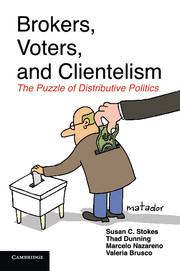Book contents
- Frontmatter
- Dedication
- Contents
- List of Tables
- List of Figures
- Preface and Acknowledgments
- I MODALITIES OF DISTRIBUTIVE POLITICS
- II THE MICRO-LOGIC OF CLIENTELISM
- 2 Gaps Between Theory and Fact
- 3 A Theory of Broker-Mediated Distribution
- 4 Testing the Theory of Broker-Mediated Distribution
- 5 A Disjunction Between the Strategies of Leaders and Brokers?
- 6 Clientelism and Poverty
- III THE MACRO-LOGIC OF VOTE BUYING: WHAT EXPLAINS THE RISE AND DECLINE OF POLITICAL MACHINES?
- IV CLIENTELISM AND DEMOCRATIC THEORY
- Appendix A: Argentina Brokers' Survey
- Appendix B: Argentina Voters' Surveys
- Appendix C: Venezuela Voters' Survey and the Maisanta Database
- Appendix D: India Voters' Survey
- References
- Index
- Miscellaneous Endmatter
2 - Gaps Between Theory and Fact
Published online by Cambridge University Press: 05 June 2014
- Frontmatter
- Dedication
- Contents
- List of Tables
- List of Figures
- Preface and Acknowledgments
- I MODALITIES OF DISTRIBUTIVE POLITICS
- II THE MICRO-LOGIC OF CLIENTELISM
- 2 Gaps Between Theory and Fact
- 3 A Theory of Broker-Mediated Distribution
- 4 Testing the Theory of Broker-Mediated Distribution
- 5 A Disjunction Between the Strategies of Leaders and Brokers?
- 6 Clientelism and Poverty
- III THE MACRO-LOGIC OF VOTE BUYING: WHAT EXPLAINS THE RISE AND DECLINE OF POLITICAL MACHINES?
- IV CLIENTELISM AND DEMOCRATIC THEORY
- Appendix A: Argentina Brokers' Survey
- Appendix B: Argentina Voters' Surveys
- Appendix C: Venezuela Voters' Survey and the Maisanta Database
- Appendix D: India Voters' Survey
- References
- Index
- Miscellaneous Endmatter
Summary
“The groups that are densely represented at the center [of the ideological spectrum] will be the beneficiaries of redistributive politics. [Groups at the extremes] will not partake in this benefit: they will be written off by one party and taken for granted by the other.”
“A broker will give goods to swing voters to attract more people; voters who prefer the party are already on his side.”
The first quote expresses a theoretical finding about partisan attachments and distributive politics. The second one expresses the same idea, this time voiced by a low-level operative in an Argentine political party. What has become the dominant view among theorists is the same as this practitioner's rule of thumb: a party will not waste its resources on loyal supporters (or on die-hard enemies), but instead spend on swing voters. The reason is that parties will use largesse to change people's votes; swing voters, with no prior commitment to one party or another, will be uniquely responsive.
The intuition behind the theory and rule of thumb is straightforward. However, as we show in this chapter, it is not supported by the facts. Reality stubbornly resists conforming to our theories. In a range of developing-world democracies, swing voters receive too few benefits, whereas loyal voters – those whose strong preference for the party should make them unresponsive – receive too many.
- Type
- Chapter
- Information
- Brokers, Voters, and ClientelismThe Puzzle of Distributive Politics, pp. 31 - 74Publisher: Cambridge University PressPrint publication year: 2013



